
he Isle of Man is roughly thirty-three miles long and thirteen miles at its widest point, and is situated in the Irish Sea within sight of England, Scotland and Ireland. The early settlers came under the influence of Irish Christian missionaries in the 5th century, and a Manx language and culture developed which Viking invasions from about 800 onwards failed to eradicate. A "Kingdom of Man and the Isles" was established centred on Man but including many of the Western Isles of Scotland and often dominated by Norway. This maritime kingdom was at its most powerful between 1079 and 1265 but it was annexed by Scotland in that year and then conquered by England in 1333. Subsequently it was ruled for more than four centuries as a semi-autonomous lordship by noblemen owing allegiance to the English monarch. In 1765, because of large-scale smuggling, the British Government resumed direct responsibility for the Island and appointed lieutenant-governors to administer it, though its special constitutional status was preserved, along with its local parliament, "Tynwald." This has its origin during the Viking ascendancy of the 10th century, giving it a claim to be the oldest continuous parliamentary assembly in the world.
When Victoria came to the throne in 1837 the Island had about 42,000 inhabitants, 70% of them based in the countryside where they attempted to keep body and soul together through the traditional occupations of farming and fishing. Mining for lead in Laxey became very profitable after the installation in 1854 of the "Lady Isabella," then the largest water-wheel in the world, designed to pump water from the mine-shafts. Though the ancient capital was Castletown, named after its fine medieval fortress, Douglas was the largest town, with a population of about 9,000 compared with Castletown, Peel and Ramsey, which had less than 2,000 inhabitants each.
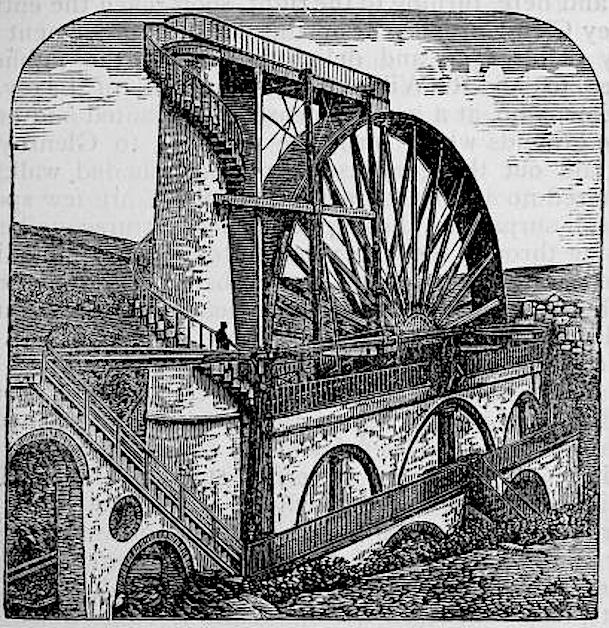
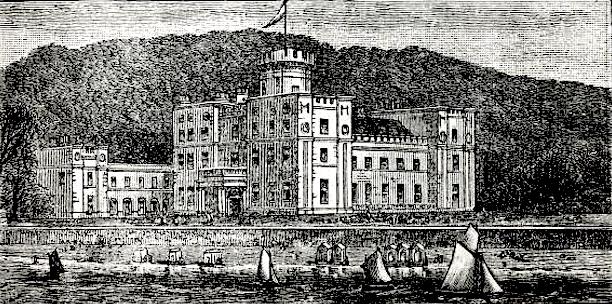
Two illustrations from Brown's Popular Guide. Left: "Great Laxey Wheel" (The "Lady Isabella" water-wheel in Laxey), p. 193. Right: "Castle Mona," p. 48. [Click on all the images to enlarge them.]
In 1845 Victoria and Albert bought Osborne House on the Isle of Wight as a holiday retreat but it seems that Castle Mona, a mansion on Douglas Bay built by the fourth Duke of Atholl in 1804, was also under consideration as a northern home. In September 1847 Victoria, Albert and their young children arrived off Ramsey in an unscheduled visit of the Royal Yacht, which had been taking them on a cruise. Victoria was nervous about the choppy water and stayed on board but Albert was rowed to shore in a small boat and had a good look round. No doubt they sailed on to view Castle Mona from the yacht but eventually they found what they were looking for at Balmoral Castle in the Scottish Highlands. Castle Mona was actually run as a successful hotel for the gentry at that time because the Island had a lower tax regime than the UK and was very popular with retired military and naval personnel on fixed pensions. Most of them settled in Douglas and many fine houses and terraces in the Georgian style were built to accommodate them.
This sleepy and somewhat impoverished backwater was revolutionized in 1863 by the arrival of a new and energetic young lieutenant-governor called Henry Loch. His first master-stroke was to persuade the House of Keys (the lower house of Tynwald) to become an elected assembly in return for assuming more control over the Island's finances. He then set about transforming the Island into a major holiday destination for the working-class population of north-western England and Scotland, who could make their way on the new railway network to ports from which they could be ferried to the Isle of Man. Loch persuaded the Duke of Sutherland to back a narrow-gauge steam railway system on the Island and this made Peel and Ramsey into viable holiday destinations as well as the small coastal villages of Port St Mary and Port Erin. Ranges of Victorian hotels were rapidly built in all these towns as well as in Douglas, which boasted an impressive "Loch Parade," while Ramsey was provided with one of Britain's longest piers. A horse tramway along Douglas Bay opened in 1876 and is still going strong today, as is the Electric Tramway travelling north from Douglas which opened in 1893.

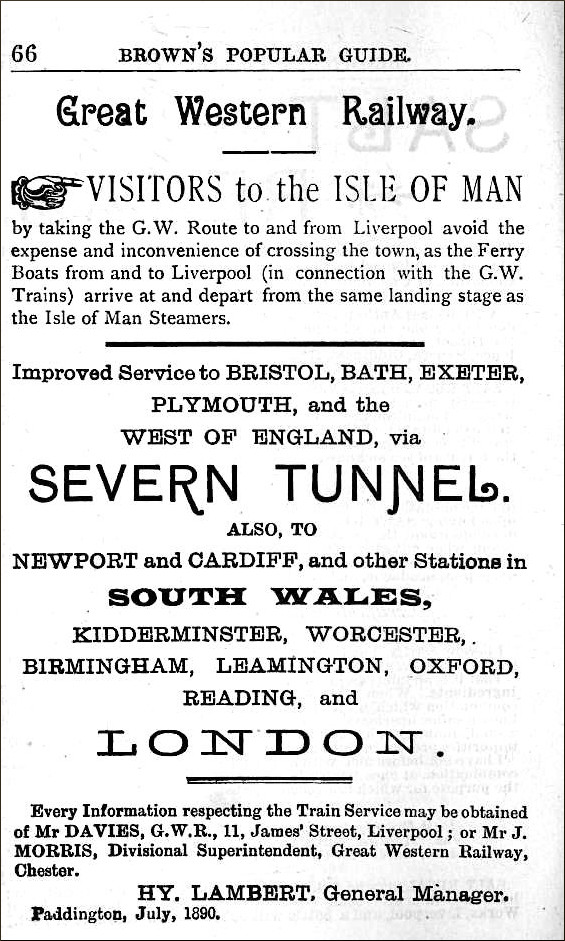
Left: The Fenella, an 0-4-0 tank engine on the Isle of Man Railway, standing adjacent to the watertank (photo by George Landow; click on this for more images. Right: Advert for the Great Western Railway in Brown's Guide, p. 66.
When Loch arrived on the Island in 1863 visitor numbers were about 60,000 a year. Ten years later they were 90,000 and by the time he left in 1882, with a well-deserved knighthood, they had doubled to 180,000. Then followed years of frantic expansion of hotels, theatres and ballrooms so that by 1887, the year of Victoria's Golden Jubilee, there were nearly 350,000 visitors. The year after his mother's death, Edward VII became the first British reigning monarch to visit the Island and in 1913 there were about 634,000 visitors before everything came to a halt with the outbreak of war the following year.
Many of the Victorian hotels and boarding houses have since been demolished to make way for apartment blocks and the Island's function as a mass holiday destination has been replaced by other roles, especially as an offshore finance centre. Castletown and Peel are dominated by impressive medieval fortresses but Douglas still looks predominantly Victorian and has been considered (by Country Life) one of Britain's three most attractive seaside resorts, along with Weymouth and Llandudno. Although King Charles III is undoubtedly its lawful sovereign the Island is not part of the United Kingdom and jealously guards the considerable degree of independence that it enjoys.

Sir Hall Caine, The Studio 13 (1898): 271.
The most famous Manxman on the Victorian cultural scene was Sir Hall Caine (b. 1853) whose melodramatic novels, though out of fashion now, sold millions in his lifetime. More highbrow was Thomas Edward Brown (b. 1830) a brilliant Oxford academic who earned his living in Bristol as a schoolmaster at Clifton College but wrote long poems about the Isle of Man, often in a Manx dialect, which won high praise from the London intelligentsia and were published in several volumes by the prestigious house of Macmillan. Some time after Brown's death he was hailed on the Island as the Manx National Poet. Archibald Knox (b. 1864) is still highly respected internationally as an artist and designer who worked for Liberty's in London and had a considerable influence on British design. The most notable Victorian philanthropist on the Island was the childless businessman Henry Bloom Noble who died in 1903, leaving his large fortune for many charitable projects, especially in healthcare and education, several of which continue to bear his name.
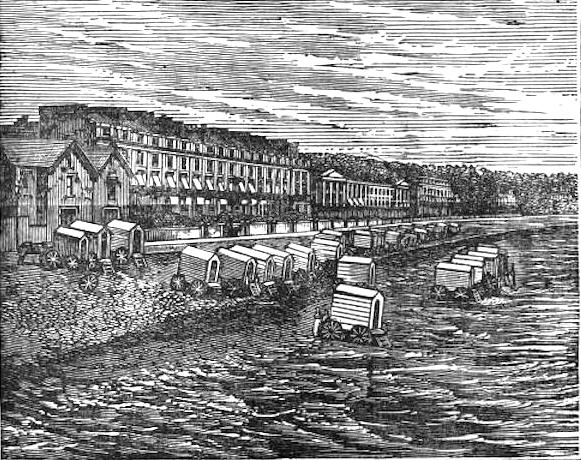
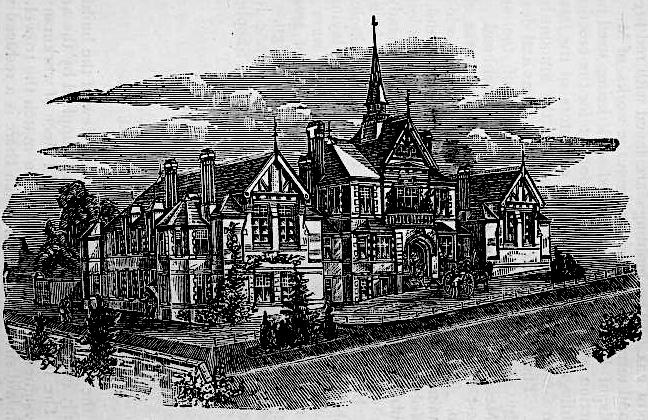
Two more illustrations from Brown's Popular Guide to the Isle of Man, 1894. Left: A little way on from Loch Parade, the "Douglas Bathing Ground," p.68. Right: "Noble's Isle of Man Hospital," p. 38.
Illustration Sources
Brown's Popular Guide to the Isle of Man. Douglas, Isle of Man: James Brown, 1894. Internet Archive, from a copy in the University of Illinois. Web. 9 October 2023.
The Studio 13 (1898): 271: Internet Archive, Web. 24 December 2010.
Further Reading
"A Manx Notebook" (manxnotebook.com), edited by Frances Coakley, is a very extensive online collection of primary source material for the Island, especially in the nineteenth century.
Winterbottom, Derek. T. E. Brown, His Life and Legacy: A Biography. Douglas, Isle of Man: The Manx Experience, 1997. Internet Archive, digitised by the Bristol Record Society. Web. 9 October 2023.
_____. "Economic History." A New History of the Isle of Man. Vol. 5. Edited by John Belchem. Liverpool: Liverpool University Press, 2000.
_____. Governors of the Isle of Man since 1765. 1999. 2nd ed. Douglas, Isle of Man: Manx Heritage Foundation, 2012.
_____. Henry Bloom Noble: His life and the Work of his Trust. Douglas, Isle of Man: Manx Heritage Foundation, 2005.
_____. Profile of Castletown. Ramsey, Isle of Man: Lily Publications, 2010.
_____. Profile of the Isle of Man. Ramsey, Isle of Man: Lily Publications, 2007.
_____. Sophia Morrison, Mona Douglas and their Enchanted Isle. Isle of Man: Alondra Books, 2019.
Created 9 October 2023